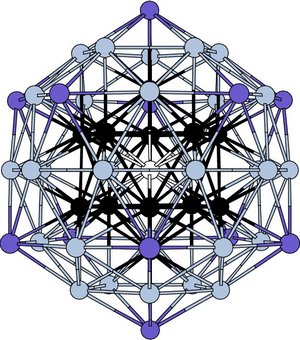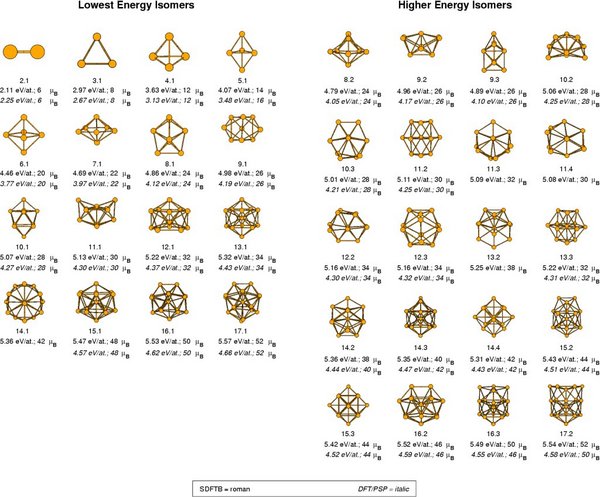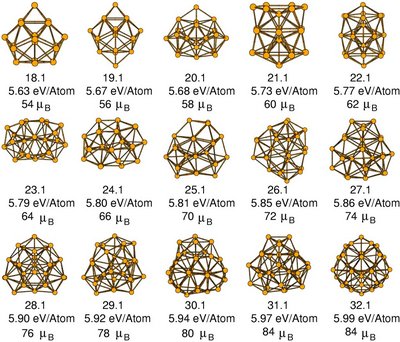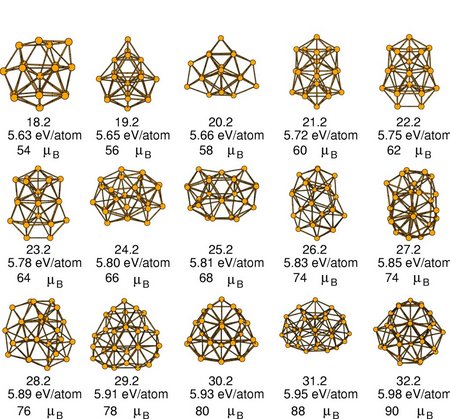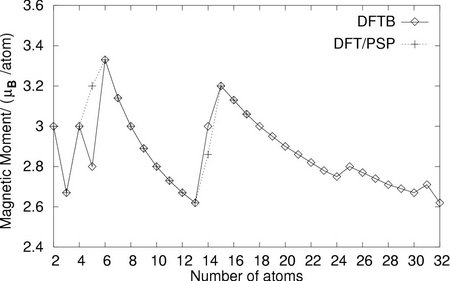Clusters
The cluster activities in the group of Prof. Frauenheim focus on two materials:
- iron clusters and their magnetic properties and
- silicon clusters and their shape transitions.
Different search algorithms have been employed to sample the potential hypersurfaces, a genetic algorithm for the iron clusters as well as molecular dynamics and the " big bang " algorithm for silicon clusters.
Additionally, some work has been done on silicon-nitride clusters.
Iron Clusters
Motivation
Clusters are molecular systems in the size range up to several hundred atoms. What distinguishes a cluster from bulk material are finite size effects. These effects strongly influence the electronic, magnetic and optical properties and thus lead to novell material properties which are hoped to be useful on an industrial scale. The focus of the work presented herein is on the interesting magnetic properties of iron clusters.
Transition metal clusters (Fe, Co, Ni) have been investigated with experimental methods for a relatively long time. Especially gas phase experiments have elucidated the electronic <link htdocs groups frauenheim projects fullerenes_clusters>[1] ,<link htdocs groups frauenheim projects fullerenes_clusters>[2], <link htdocs groups frauenheim projects fullerenes_clusters>[3] as well as magnetic properties <link htdocs groups frauenheim projects fullerenes_clusters>[4],<link htdocs groups frauenheim projects fullerenes_clusters>[5],<link htdocs groups frauenheim projects fullerenes_clusters>[6],<link htdocs groups frauenheim projects fullerenes_clusters>[7],<link htdocs groups frauenheim projects fullerenes_clusters>[8],<link htdocs groups frauenheim projects fullerenes_clusters>[9] of these clusters. In the molecular beam data for iron several magnetisation peaks are present <link htdocs groups frauenheim projects fullerenes_clusters>[5].
These experiments usually give no direct insight into atomistic properties, e. g. structures, of the observed clusters and therefore cannot explain the size dependent peaks of the magnetic moments for the iron clusters. Therefore, theoretical investigations are necessary. Since a geometry is necessary for all calculations good sampling of the potential energy hypersurface (PES) and especially the energetically most favourable isomers of each size is often crucial for comparison to experimental data.
Through scanning of the cluster PES is a computationally very demanding task, especially for transition metal clusters where spin effects have to be taken into account. This has limited early work to only a few atoms <link htdocs groups frauenheim projects fullerenes_clusters>[10],<link htdocs groups frauenheim projects fullerenes_clusters>[11],<link htdocs groups frauenheim projects fullerenes_clusters>[12],<link htdocs groups frauenheim projects fullerenes_clusters>[13] or to highly symmetric structures <link htdocs groups frauenheim projects fullerenes_clusters>[14],<link htdocs groups frauenheim projects fullerenes_clusters>[15]. Only recently, detailed density functional theory (DFT) <link htdocs groups frauenheim projects fullerenes_clusters>[16],<link htdocs groups frauenheim projects fullerenes_clusters>[17] studies for relatively large clusters with up to 17 <link htdocs groups frauenheim projects fullerenes_clusters>[18] and 26 <link htdocs groups frauenheim projects fullerenes_clusters>[19] atoms focusing on the spin magnetic moments have been published.
Most recently a detailed DFT study <link htdocs groups frauenheim projects fullerenes_clusters>[20], using the above mentioned combined DFT/DFTB approach, of spin ordering in the Fe13 icosahedron has been published. From these results a delicate interplay between spin ordering, e. g. ferromagnetic versus anti-ferromagnetic, and geometry becomes apparent. Also, some dependency on the exchange-correlation functional has been observed.
For reliably addressing large transition metal clusters including dozens of atoms with detailed and efficient unconstrained scanning of the PES, an alternative approach combining DFT accuracy in energies and magnetic moments with TB efficiency would be highly desirable. Based on the very encouraging results obtained by combining the DFTB approach with DFT <link htdocs groups frauenheim projects fullerenes_clusters>[19]we have adopted this approach using spinpolarised DFTB as the high level method for clusters up to Fe32. Applying a genetic algorithm based search for low energy iron cluster isomers in Section <link htdocs groups frauenheim projects fullerenes_clusters>geometries are described for an extended size range up to Fe32.
Structural evolution
The <link htdocs groups frauenheim projects fullerenes_clusters>figure 1 shows the cluster structures in the size range from Fe2 to Fe17. The binding energies and average spin magnetic moments are given along with DFT/PSP data <link htdocs groups frauenheim projects fullerenes_clusters>[18] for comparison.
We find generally a very good agreement with regard to structures, energetical ordering and magnetic moments. Especially the transition from icosahedral to non-icosahedral structures at Fe13 is clearly reflected in the DFTB results. Its influence on the magnetic properties is discussed later.
The energetically most favourable( <link htdocs groups frauenheim projects fullerenes_clusters>figure 2) and less favourable ( <link htdocs groups frauenheim projects fullerenes_clusters>figure 3) structures in the range from 18 to 32 atoms show a clear structural evolution. The structure labeled 19.1 us identical to 18.1 with an additional atom. The change from Fe19 Fe20 is quite large. This again is connected to the appearance of an structure with icosahedral elements (20.1) while 20.2 is based on the non-icosahedral Fe15 cluster. Both, 21.1 and 21.2 are than based on 20.2 incorporating one more atom. Capping of 21.1 leads to 22.1 which again contains the structure 15.1 as building blocks. Similarly, the second best structure 22.2 evolves directly from cluster 21.1 by bicapping one ring. This continues to structure 23.2 where one more atom is placed in the five-membered ring of cluster 22.2.
The structural evolution of clusters from Fe24 to Fe32 is more complicated. These structures are often based on 22.1 or 22.2 with the additional atoms attached to various positions. This leads to some structural distortions of the basic building elements.
Magnetic Moments
The development of the clusters magnetic moments( <link htdocs groups frauenheim projects fullerenes_clusters>figure 4) shows a clear connection to the change from icosahedral to non-icosahedral structures at Fe13. This is connected to non ferromagnetic spin ordering, see below. For larger clusters a relatively smooth decrease of the magnetic moment is visible. The two small peaks cannot be clearly connected to structural changes.

